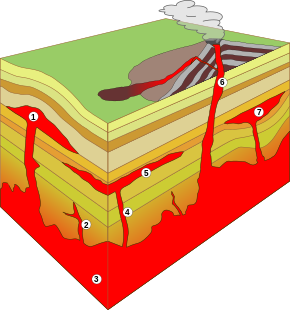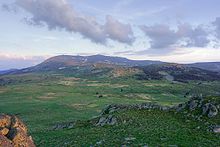Batholith

Abatholith(fromAncient Greekbathos'depth', andlithos'rock') is a large mass ofintrusiveigneous rock(also called plutonic rock), larger than 100 km2(40 sq mi) in area,[1]that forms from cooledmagmadeep in theEarth's crust.Batholiths are almost always made mostly offelsicorintermediaterock types, such asgranite,quartz monzonite,ordiorite(see alsogranite dome).

1.Laccolith
2. Smalldike
3.Batholith
4.Dike
5.Sill
6.Volcanic neckandpipe
7.Lopolith
Note: As a general rule, in contrast to the active volcanic vent in the figure, these names refer to the fully cooled and usually millions-of-years-old rock formations, which are the result of the underground magmatic activity shown.
Formation[edit]
Although they may appear uniform, batholiths are in fact structures with complex histories and compositions. They are composed of multiple masses, orplutons,bodies of igneous rock of irregular dimensions (typically at least several kilometers) that can be distinguished from adjacent igneous rock by some combination of criteria including age, composition, texture, or mappable structures. Individual plutons are solidified from magma that traveled toward the surface from a zone ofpartial meltingnear the base of the Earth's crust.

Traditionally, these plutons have been considered to form by ascent of relatively buoyant magma in large masses calledplutonicdiapirs.Because the diapirs are liquified and very hot, they tend to rise through the surrounding nativecountry rock,pushing it aside and partially melting it. Most diapirs do not reach the surface to formvolcanoes,but instead they slow down, cool, and usually solidify 5 to 30 kilometers underground as plutons (hence the use of the wordpluton;in reference to theRomangod of the underworldPluto). An alternate view is that plutons are formed by aggregation of smaller volumes of magma that ascend asdikes.[2]
A batholith is formed when many plutons converge to form a huge expanse of granitic rock. Some batholiths are mammoth, paralleling past and presentsubductionzones and other heat sources for hundreds of kilometers incontinental crust.One such batholith is theSierra Nevada Batholith,which is a continuous granitic formation that makes up much of theSierra Nevadain California. An even larger batholith, theCoast Plutonic Complex,is found predominantly in theCoast Mountainsof western Canada; it extends for 1,800 kilometers and reaches into southeastern Alaska.
Surface expression and erosion[edit]
A batholith is an exposed area of (mostly) continuous plutonic rock that covers an area larger than 100 square kilometers (40 square miles). Areas smaller than 100 square kilometers are calledstocks.[3]However, the majority of batholiths visible at the surface (via outcroppings) have areas far greater than 100 square kilometers. These areas are exposed to the surface through the process oferosionaccelerated bycontinental upliftacting over many tens of millions to hundreds of millions of years. This process has removed several tens of square kilometers of overlying rock in many areas, exposing the once deeply buried batholiths.
Batholiths exposed at the surface are subjected to huge pressure differences between their former location deep in the earth and their new location at or near the surface. As a result, theircrystal structureexpands slightly over time. This manifests itself by a form ofmass wastingcalledexfoliation.This form of weathering causes convex and relatively thin sheets of rock to slough off the exposed surfaces of batholiths (a process accelerated byfrost wedging). The result is fairly clean and rounded rock faces. A well-known result of this process isHalf DomeinYosemite Valley.
Examples[edit]
Africa[edit]
Antarctica[edit]
Asia[edit]
Europe[edit]
|
North America[edit]
Oceania[edit]
South America[edit]
|
See also[edit]
References[edit]
- ^Petersen, James F.; Sack, Dorothy; Gabler, Robert E. (2017).Physical Geography(11th ed.). Boston:CengageLearning Inc. p. 614.ISBN978-1-305-65264-4.
- ^Hall, Clarence A. Jr. (2007).Introduction to the geology of southern California and its native plants.Berkeley: University of California Press. p. 22.ISBN9780520249325.
- ^GLENCOE SCIENCE | Earth Science Twelfth Grade High School Textbook (Georgia); pg. 115 paragraph 1, pg. 521 question 9
- ^Clemens, J.D.; Belcher, R.W; Kisters, A.F.M. (2010)."The Heerenveen Batholith, Barberton Mountain Land, South Africa: Mesoarchaean, Potassic, Felsic Magmas Formed by Melting of an Ancient Subduction Complex".Journal of Petrology.51(5): 1099–1120.doi:10.1093/petrology/egq014.
{{cite journal}}:CS1 maint: multiple names: authors list (link) - ^"Bhongir fort's batholith marvel".June 2016.
- ^"Rapid Uplift: Mount Abu Geology".22 July 2018.
- ^Erik H. Erikson Jr."Petrogenesis of the Mount Stuart Batholith Plutonic Equivalent of the High-Aluina Basalt Association"(PDF).
The Mount Stuart batholith is a Late Cretaceous calc-alkaline pluton composed of intrusive phases ranging in composition from two-pyroxene gabbro to granite.
- ^Myrl E. BeckJr.; Russell F. Burmester; Ruth Schoonover."Paleomagnetism and tectonics of the Cretaceous Mt. Stuart Batholith of Washington: translation or tilt?".
The Mt. Stuart Batholith is a composite pluton of Late Cretaceous age that intrudes the crystalline North Cascades terrane of northwestern Washington.
- ^Morton, Douglas M.; Miller, Fred K. (2014).Douglas M. Morton, Fred K. Miller, Peninsular Ranges Batholith, Baja and Southern California, Geological Society of America, 2014.ISBN9780813712116.
- ^Davin A. Bagdonas; Carol D. Frost; C. Mark Fanning (2016)."The origin of extensive Neoarchean high-silica batholiths and the nature of intrusive complements to silicic ignimbrites: Insights from the Wyoming batholith, U.S.A."(PDF).American Mineralogist.101(6): 1332–1347.Bibcode:2016AmMin.101.1332B.doi:10.2138/am-2016-5512.S2CID131845599.RetrievedJune 8,2016.
...Neoarchean granite batholith, herein named the Wyoming batholith, extends more than 200 km across central Wyoming in the Granite and the Laramie Mountains.
- ^Stratigraphic revision and remapping of the Mathinna Supergroup between the River Tamar and the Scottsdale Batholith, northeast Tasmania,Department of Infrastructure, Energy and Resources. Mineral Resources Tasmania. June 2011
- Plummer, McGeary, Carlson,Physical Geology,Eighth Edition (McGraw-Hill: Boston, 1999) pages 61–63ISBN0-697-37404-1
- Glazner, Bartley, Coleman, Gray, Taylor,Are plutons assembled over millions of years by amalgamation from small magma chambers?,GSA Today: Vol. 14, No. 4, pp. 4–11
